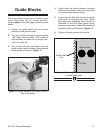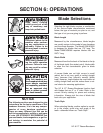
-22- 24" & 27" Resaw Bandsaws
Using this machine pro-
duces sawdust which may
cause allergic reactions
and respiratory problems.
Use an approved dust
mask to protect yourself
from these hazards!
SECTION 6: OPERATIONS
Keep loose clothing
rolled up and out of the
way of machinery and
keep hair pulled back.
Wear safety glasses dur-
ing the entire operation
process. Failure to com-
ply may result in serious
personal injury.
Disconnect power to the
machine when perform-
ing any maintenance or
assembly. Failure to do
this may result in serious
personal injury.
Blade Selections
NOTICE
The following section was designed to give
instructions on the basic operations of this
bandsaw. However, it is in no way compre-
hensive of every bandsaw application.
There are many different jigs that can be
built to increase safety, accuracy, and types
of cuts. WE STRONGLY RECOMMEND that
you read books, trade magazines, or get for-
mal training to maximize the potential of
your machine.
Selecting the right blade requires a combination
of the various blade characteristics mentioned
below, the type of material you plan to cut, and
the type of cut you are going to perform.
Blade Length
Measured by the circumference, blade lengths
are usually unique to the model of your bandsaw
and the wheel diameter. The Model G3619/3620
is designed for blades that are 175" long. The
Model G9963/G9966 requires blades that are
206
3
⁄4" long.
Blade Width
Measured from the the back of the blade to the tip
of the blade tooth (the widest point), blade width
is often the first consideration given to blade
selection.
A narrow blade can cut tight curves (a small
radius) but is not very good at cutting straight
lines, because they naturally wander (blade
lead). However, larger blades are much better at
cutting straight lines and this makes them a nat-
ural choice for resawing applications
The 24" & 27" Resaw Bandsaws function best
with blades that are 2" or 3" wide. Refer to the
current Grizzly catalog for prices and ordering
information. Always pick the size of blade that
best suits your application.
Tooth Style
When selecting blades, another option to consid-
er is the shape, gullet size and angle of the
teeth—otherwise known as “Tooth Style.”


















